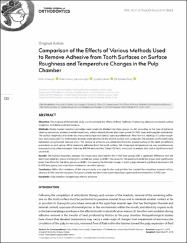| dc.contributor.author | Amasyalı, Mihri | |
| dc.contributor.author | Alakuş Sabuncuoğlu, Fidan | |
| dc.contributor.author | Erşahan, Şeyda | |
| dc.contributor.author | Oktay, Elif Aybala | |
| dc.date.accessioned | 2019-12-27T08:54:06Z | |
| dc.date.available | 2019-12-27T08:54:06Z | |
| dc.date.issued | 2019 | en_US |
| dc.identifier.citation | Amasyalı, M., Alakuş Sabuncuoğlu, F., Erşahan, Ş. ve Oktay, E. A. (2019). Comparison of the effects of various methods used to remove adhesive from tooth surfaces on surface roughness and temperature changes in the pulp chamber. Turkish Journal of Orthodontics, 32(3), 132-138. https://doi.org/10.5152/TurkJOrthod.2019.18063 | en_US |
| dc.identifier.issn | 2148-9505 | |
| dc.identifier.uri | https://doi.org/10.5152/TurkJOrthod.2019.18063 | |
| dc.identifier.uri | https://hdl.handle.net/20.500.12511/4764 | |
| dc.description.abstract | Objective: The purpose of the present study was to compare the effects of three methods of removing adhesive on enamel surface roughness and dental pulp temperature. Methods: Ninety human maxillary premolars were randomly divided into three groups (n=30) according to the type of adhesive clean-up procedure: aluminum oxide-based burs, erbium-doped yttrium aluminum garnet (Er:YAG) laser, and tungsten carbide bur. The surface roughness of enamel was measured using a non-contact optical profilometer. After the first readings of surface roughness were measured (T1), orthodontic brackets were attached to the enamel surface with composite. The brackets on the teeth were debonded using bracket removal pliers. The residue of adhesive was eliminated from the enamel surface of the teeth by different procedures in each group. While removing adhesive from the tooth surface, the intrapulpal temperature rise was simultaneously measured using a thermocouple. One-way ANOVA and post-hoc Tukey HSD tests were used to analyze data with a significance level set at 0.05. Results: The highest roughness average (Ra) values were observed for the Er:YAG laser group, with a significant difference with the aluminum oxide bur group and tungsten carbide bur group (p<0.001). Ra values for the aluminum oxide bur group were significantly lower than those for the other groups (p<0.001). Comparing the thermal changes in each group showed a significant decrease in the Er:YAG laser group, but a significant increase in two other groups. Conclusion: Within the limitations of the present study, one-step finisher and polisher bur created the smoothest enamel surface, whereas Er:YAG laser the roughest. Tungsten carbide and aluminum oxide-based burs generated more heat than Er:YAG laser. | en_US |
| dc.language.iso | eng | en_US |
| dc.publisher | AVES | en_US |
| dc.rights | info:eu-repo/semantics/openAccess | en_US |
| dc.subject | Pulp Chamber | en_US |
| dc.subject | Temperature | en_US |
| dc.subject | Remove Adhesive | en_US |
| dc.title | Comparison of the effects of various methods used to remove adhesive from tooth surfaces on surface roughness and temperature changes in the pulp chamber | en_US |
| dc.type | article | en_US |
| dc.relation.ispartof | Turkish Journal of Orthodontics | en_US |
| dc.department | İstanbul Medipol Üniversitesi, Diş Hekimliği Fakültesi, Endodonti Ana Bilim Dalı | en_US |
| dc.authorid | 0000-0003-4716-948X | en_US |
| dc.identifier.volume | 32 | en_US |
| dc.identifier.issue | 3 | en_US |
| dc.identifier.startpage | 132 | en_US |
| dc.identifier.endpage | 138 | en_US |
| dc.relation.publicationcategory | Makale - Uluslararası Hakemli Dergi - Kurum Öğretim Elemanı | en_US |
| dc.identifier.doi | 10.5152/TurkJOrthod.2019.18063 | en_US |
| dc.identifier.scopusquality | Q4 | en_US |


















